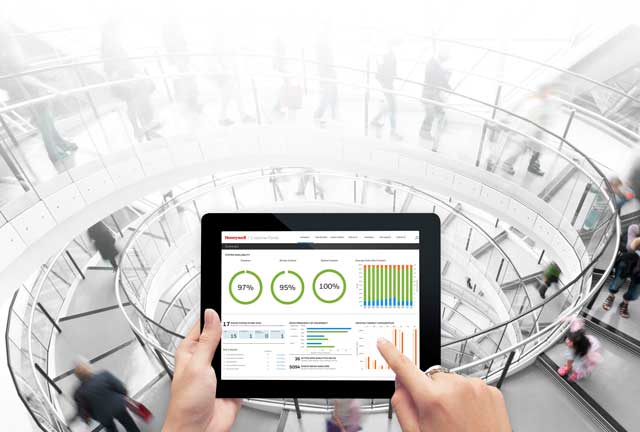 In recent years, more and more organisations – in every sector – have explored smart avenues to get the most out of their existing building assets. Whether this is driven by increased demand from the board to reduce overheads or the proliferation of integrated technologies like the internet of things, Paul Mason, European Digital Services Leader at Honeywell Building Solutions says one thing is certain: the global movement of establishing smart buildings is not about to slow down.
In recent years, more and more organisations – in every sector – have explored smart avenues to get the most out of their existing building assets. Whether this is driven by increased demand from the board to reduce overheads or the proliferation of integrated technologies like the internet of things, Paul Mason, European Digital Services Leader at Honeywell Building Solutions says one thing is certain: the global movement of establishing smart buildings is not about to slow down.
According to a recent report by Zion Market Research, the global smart building market is expected to grow to $36bn (£27bn) by 2020. This represents a significant rise in value compared with 2014 – when the industry was valued at $7bn (£5.3bn)
The life of the plant manager has been made substantially easier by the rise of smart technologies. By incorporating smart solutions such as smart lighting or occupancy mapping into their building, they can reduce energy consumption – which has clear environmental benefits. Additional benefits include managers being afforded greater visibility of assets and ease of reporting, for example. Furthermore, there are financial benefits for the business itself – shown in a recent Intel study. Having deployed IoT technologies in HVAC systems, lighting systems and even certain types of electrical loads, an organisation operating in a space of approximately 75,000 square feet, with annual energy bills averaging £1.76 per square foot, can potentially save anywhere between £11,000 and £38,000 ($15,000-50,000) each year.
Why is energy efficiency now more important than ever?
The introduction of new laws and regulations means buildings must be as energy-efficient as possible. In the UK, a provision of the 2015 Energy Efficiency Regulations means that new leases cannot be granted to commercial properties with an energy performance certificate rating of less than ‘E’ in England and Wales from 1 April next year.
The obvious question is how can smart technology help make building assets even more efficient? One choice that facility managers have is smart lighting. If an organisation decides to update its energy management system to include smart lighting, the lighting can be turned on and off or adjusted according to occupancy. Energy use can be reduced by a significant amount, and the company is one step closer to achieving an improved EPC rating.
Furthermore, the concept of smart lighting can be applied to other assets within a building. Take air conditioning, for example. When there are less people occupying a building, air conditioning levels can be altered. Again, this leaves organisations with a better chance of complying with the upcoming regulatory changes.
A further incentive can be found in the cost savings smart technologies generate. Smart technologies have the ability to transform a building into an important asset for a company. Reducing the operational hours of equipment such as HVAC plant results in an increase in asset life. By cutting energy costs, operational capital is freed to be used elsewhere.
Processing data in the cloud
Smart buildings provide plant managers and engineers with an overwhelming amount of data, and the cloud provides the network of servers needed to store, manage, and process it. That being said, merely having data does not offer businesses the same value as knowing how to extract the right data. With the assistance of algorithms and visualisation software, to have information flowing through an organisation in an understandable way puts building experts in a better position to identify anomalies and suggest how existing assets and energy use can be optimised.
Businesses can combine different data sets within a single cloud space, for example HVAC data and space utilisation data. Facility managers are shown which parts of a building are occupied at a specific time and which are not. HVAC equipment use can then be suitably managed through building managers optimising set points and schedules. The fact that energy consumption falls and asset life rises is reflected on the company’s balance sheet, offering a competitive advantage along with a greater return.
One key thing to consider is that without smart technologies such as the cloud or fault detection algorithms and dashboards, managers and engineers can only be reactive. When this is the case, there are a number of undesirable knock-on effects. Total cost goes up and businesses can’t be as productive as they could potentially be. Smart solutions allow businesses to be on the front foot. They can study the data and detect anomalies in real time – which aids them in meeting operational targets.
When taking into account the changes imposed by energy efficiency regulations in addition to the economic and environmental incentives, making building assets sustainable should be considered a top priority for facility managers and maintenance engineers. The benefits of smart technologies are not limited to a single industrial space, but can be optimised to perform in all segments of an organisation.
It shouldn’t be a matter of if smart buildings become mainstream, rather a matter of when.
https://buildingsolutions.honeywell.com/en-US/Pages/default.aspx

